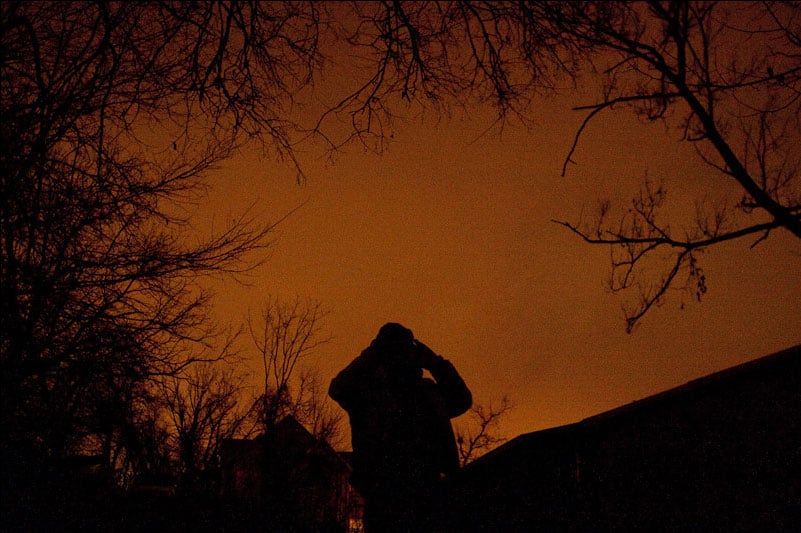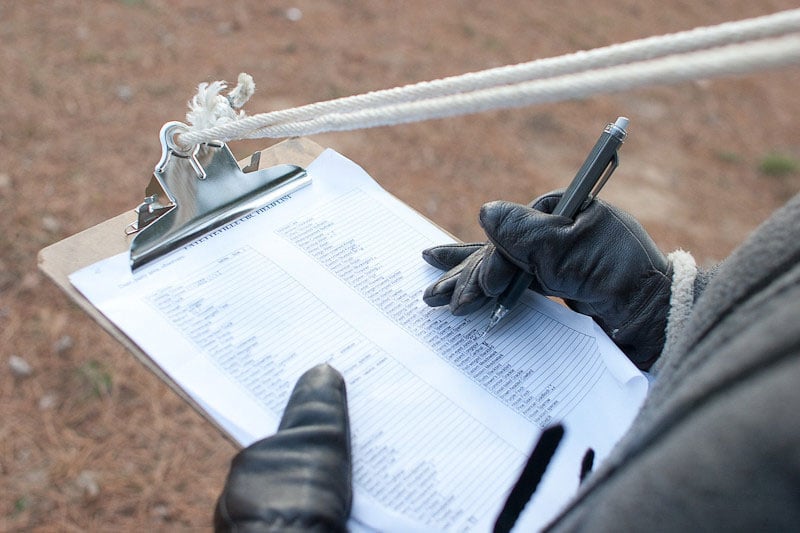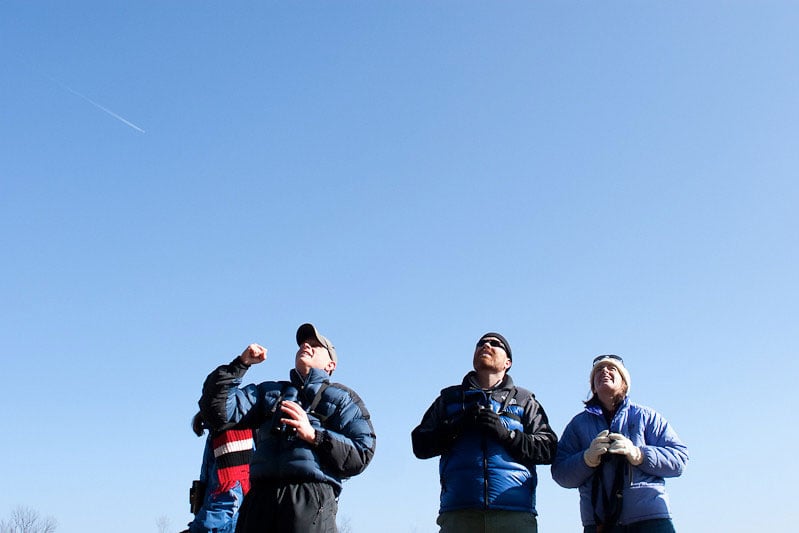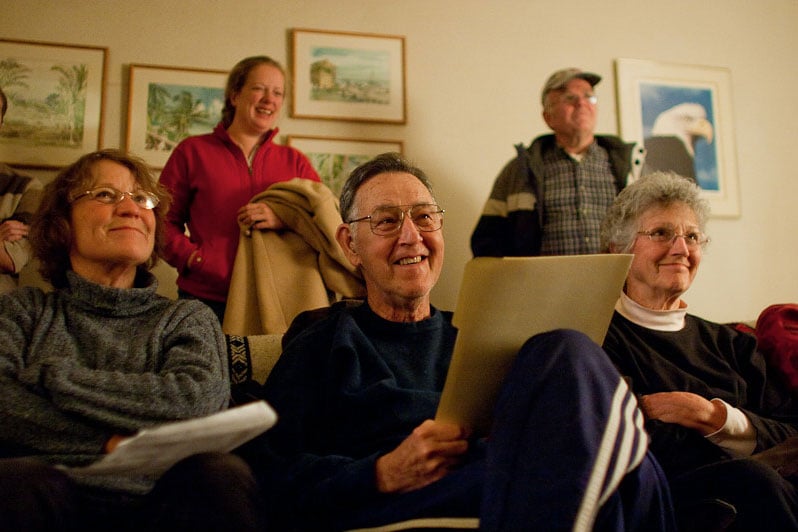This is an article about my experience tagging along on the 2009 Fayetteville Christmas Bird Count, hosted each year by the Northwest Arkansas Audubon Society. This year’s count will take place on Sunday, Dec. 19, and anyone interested in participating should contact Joe Neal ([email protected]) for more information. As you’ll read below, the Christmas Bird Count is not for the feint of heart, but it’s certainly worth knowing that it exists. My experience last year left me with pictures to share and a story to tell. You can check out the pictures on my site, but I encourage you to first read my story.
If you’ve ever known a birder, you’ve likely learned to avoid the term “bird watching.” Birders don’t just day-dreamingly watch the Robins hop about the yard, oh no. When serious birders set out for “birding”, they set goals, take notes, update lists, and employ all the powers of their eyes and ears in a pursuit far more driven than “watching.” Dedicated birders laugh in the face of 4 a.m. alarm clocks; they chuckle in the chill of a cold, wet morning. They are passionate about birds, and they spend long hours getting to know them. To refer to their activities as mere “bird watching” is an insult to their dedication.
So, picture me last year, on a cold December morning at 5 a.m. riding in a car full of true “birders” towards a farm pasture somewhere outside of Fayetteville to find, in the dark, one particular Great Horned Owl. I had signed up for the Audubon Annual Christmas Bird Count, and I was embarking one a dawn-till-dusk pursuit of any and every bird we could find in one day in Northwest Arkansas. As we pulled into a driveway and up to a dark house, I sincerely hoped that its owner had been briefed on the significance of our unusually early arrival. I, being the tag-along observer, was truly at the mercy of the birders and their avian agenda. I was there to experience what the Bird Count was all about, and to better understand why anyone would want to spend a long, cold day counting birds.

A CBC participant waits quietly in the dark, hands to her ears, listening for the call of a Screech Owl.
Back in the car, I was feeling refreshed and energized by our sighting, but Joe’s sentiments were of a more expectant satisfaction. He knew the owl was there, and knew how to call it in, because he’s a dedicated birder who’s been doing these counts for some time. “This is worth the loss of sleep,” I reminded myself. “…to be in the company of people who know immensely more than I do about something worth knowing.” Birding serves as a fine excuse to get ourselves outside and pay attention to what’s going on. This bird count was my excuse to do just that, and to learn from people who’ve been doing it all their lives. So, I sat their in the car, half asleep, half excited, day-dreaming about all these things while Joe and the others focused on the next two species of owl we expected to find before sunrise. Using owl calls, we found both species in no time: one Screech Owl near the train tracks downtown, and one Barred Owl in a wooded neighborhood on Mount Sequoyah. The Christmas Bird Count had begun.

Good list-keeping is of the utmost importance on the Christmas Bird Count.
The Christmas Bird Count is a century-long tradition organized by the National Audubon Society that harnesses the power of public participation to create an information-rich snapshot of the whereabouts and abundances of birds in the Americas. The count exemplifies the awesome power of passionate people volunteering their skills to build something that an organization like Audubon simply could not achieve alone. Each December, local Audubon chapters across the Americas choose one day to split into small teams with the mission of identifying and counting every bird they can possibly find. Last year, over 60,000 observers participated in more than 2,000 counts. 22 of those counts took place in Arkansas, where our state’s birders identified 167 different species of birds in one day.
Audubon uses the data collected from these yearly bird counts to identify broad trends in the abundance and range of bird species. A few years back, Audubon analyzed data from Christmas Bird Counts to discover that 20 of the most common birds in the continental U.S. and Canada had decreased by more than 50 percent over the last 40 years. With birds serving as a good indicator of overall environmental quality, the results of these counts have a real impact in defining broad conservation goals, measuring progress, and justifying further action.
And so, I was drawn to the Christmas Bird Count to experience first-hand this awesome day of citizen science for myself. After the success of our early morning owling, I set out tracking down different groups of birders on simultaneous counts across Northwest Arkansas. Hot spots included Lake Fayetteville, the U of A Agricultural Fields, Stone Bridge Golf Course, the Prison, and my personal favorite, the immense heap of waste somewhere near Tontitown which I lovingly referred to as “Trash Mountain.” These locations weren’t picked for their natural beauty, instead for their unique habitat offerings (natural and artificial), and the specific bird species they attracted. Most people would be shocked by the impressive number and variety of birds found in such seemingly mundane areas. I’m quite certain, in fact, that many Fayettevillians have no idea the variety of species that can be found in our own parks, backyards, and suburbs. I found myself wandering about the strangest locations, attracting many a confused look from passers by. But no matter, I relished the opportunity to be out re-discovering my home town with a completely fresh perspective, and I was lucky to have great birders as my guides.

Yesss!
As this marathon day of birding drew to a close, the groups re-converged for the culminating moment of each year’s count: the final tally. I arrived at a small, brick house just off campus with a poster of Charles Darwin on the front door. This was the home of local birding legend Doug James. Doug and Joe (the man with whom I went owling) literally wrote the book on birds in Arkansas, literally. Inside, I found a warm room full of birders, all eager to share their reports and sightings. When all the team leaders had arrived, everyone piled into the living room and Joe set about working down the list of all the possible species we might have encountered. For each species, he called around to each team leader for the number they had documented. “Bald Eagle.” Then around the room, “Zero,” “Three,” “Two,” “Four,” “One,” “Zero,” “Zero,” “Zero,” followed by a few details and anecdotes concerning the sightings. Every bird sighted that day was methodically accounted for in this way. The more common species sparked little fanfare. However, announcements of the rarer or more illusive species were met with great enthusiasm and scrutiny. Any out-of-the-ordinary sighting had to be properly scrutinized by our more senior birders, subjecting the birder who claimed the sighting to careful questioning so as to avoid any false reporting.
Sitting in that room, tallying bird sightings with these strangers, I began to answer my question of why anyone counts birds. I found it strangely beautiful to witness the sheer nerdiness of a room full of hard-core birders, because each person in that room was, at the core, a practitioner in the ever-dwindling, always-important field of natural history. Throughout human history, there have been those among us who study our natural surroundings, and through careful, repeated observation, become, in themselves, living encyclopedias of our living world. The great birders among us keep this tradition of observation alive. No book can truly supplant the wisdom of a great naturalist, because theirs is an understanding that is local, current, and constantly evolving, much like the natural communities they observe. These birders were some of Northwest Arkansas’ great naturalists: those who take the time to venture out into our natural surroundings, to observe our ever-changing environment, and to keep in touch with its current status. I saw that these birders and their knowledge represent something meaningful and important to our community.

After a long, cold day of birding, all the participants are invited to a count party to compare notes and tally numbers.
I also came to realize just how meaningful to a birder such a mundane sounding thing as a Christmas Bird Count could be. The tallying process lasted more than an hour but these birders relished each minute, and in witnessing their enjoyment, so did I. Many in the room had been participating in the Christmas Bird Count for years, even decades, and I sensed that they cherished the ritual of coming together, after a long, cold day, to share their experiences. The suspense of knowing just who saw what, and where, and under what circumstances; all these things were important. This was a special night when a room full of impassioned naturalists could join forces, and profit from the sharing of their knowledge and experience, as well as each other’s good company. In some circles, a passion for birding may seem a bit eccentric, but in this room, amongst these people, this kind of wisdom was more deeply felt and appreciated than anywhere else. This was a night for birders to come together in celebration of their common eccentricity, because together, they all knew that a passion for birding represented something more than a simple hobby, more meaningful and real.
And so, I had arrived at a pleasing answer to my question: Why count birds? Because birds are worth knowing and understanding. To know birds — their feathers, their flight, their habits and habitats — is to know a piece of the living world in which we too live. And why spend this one particular long, cold day counting birds? Because birders themselves are worth knowing and understanding as well.
This year’s Fayetteville Christmas Bird Count will be hosted on Sunday, Dec. 19 by our local Audubon Chapter. Interested birders of all abilities can contact Joe Neal to sign up for a team. If you’re interested in outings like these, but a bit intimidated by an all-day birding bonanza, our local Audubon chapter organizes plenty of field trips through out the year, the details of which can be found at nwarkaudubon.org. If you’re feeling up for the challenge of the full-on Christmas Bird Count, I’ll let you make your final decision based the invitation I received from Joe:
Y’all are hereby invited to sunrise services at Birdside Baptist, otherwise known as the Fayetteville Christmas Bird Count, Sunday, December 19th, starting as early as you can stand it, or even before, and going until you can’t take it anymore, and even a little later, if necessary.
If you’re still as excited as I am, contact Joe ([email protected]) to see about signing up. Maybe I’ll see you there.
» View all 25 of M. Taylor Long’s photos from the 2009 Christmas Bird Count
M Taylor Long is a guest contributor for the Fayetteville Flyer. He is a Fayetteville native and an avid photographer. Check out his photography and blog at mtaylorlong.com. For more of Taylor’s contributions to the Fayetteville Flyer, visit his author page.

